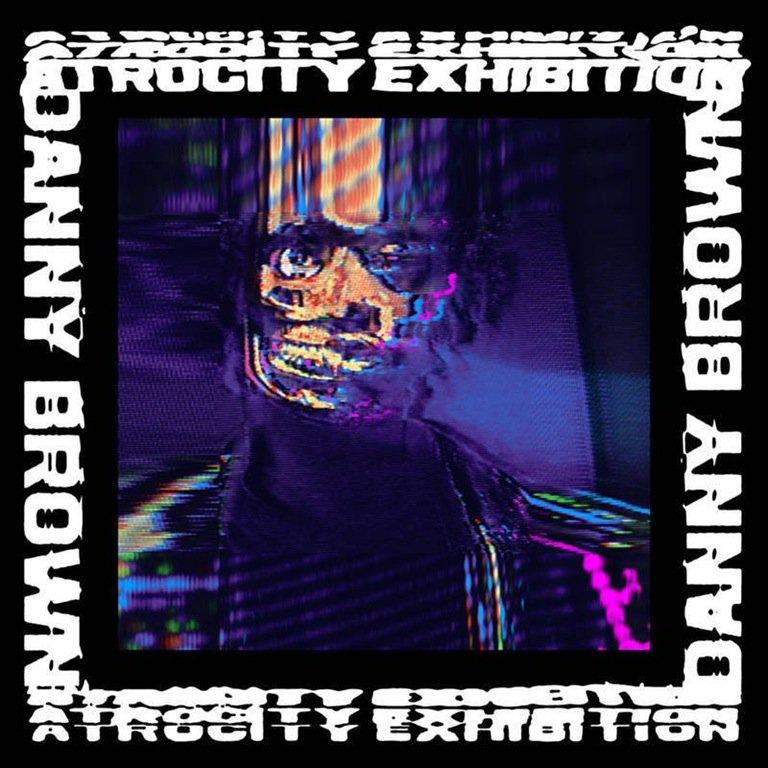Atrocity Exhibition – Danny Brown
8/10
October 13, 2016
At a glance it may seem like post-punk legends Joy Division, and rappers like Vince Staples, Kanye West, and Danny Brown have little to do with one another. However, a look at Staples’ 2015 debut album Summertime ‘06’s artwork could draw comparisons to the iconic pulsar featured on the cover of career defining work Unknown Pleasures, released by Joy Division in 1979, which Staples’ has confirmed to be his inspiration for the cover art on ‘06. Similarly, West is known to have collaborated with Peter Saville, who designed the art for Unknown Pleasures, to design his own logo. The influence of the post-punk quadruplet on rap continues to show on Detroit rapper Danny Brown’s newest album, Atrocity Exhibition, taking it’s name from the opening track of Joy Division’s second LP, Closer. Danny Brown wears the influence of the band, particularly frontman Ian Curtis’ writing on his sleeve. Under the zany, pounding production and Brown’s ridiculous, nasally vocal inflection is a deeply personal album about all of the demons he’s facing, from addiction to depression.
The 35 year old rapper, who first broke through at the ripe age of 30, is well known for his goofy, care-free persona, so it may come as some surprise that he’s releasing such a personal album. But the traces of conflict are rooted in his work as far back as his earliest releases, like the second song off of his 2011 record, XXX called “Die Like a Rockstar” that gave insight into his struggles with addiction. His problems are nothing entirely new to us, we just have been trying to sweep them under the rug.
Album opener “Downward Spiral” is a mission statement; using a drug and alcohol induced hangover after a night of partying and promiscuity as an allegory for his depression, coupled with mentions of his addiction and feelings like nobody cares about him, Brown paints a melancholy picture of muted grays and blues. Following this with flashback “Tell Me What I Don’t Know” provides information about Brown’s past and the root of his issues. The drum track is reminiscent of Joy Division’s drummer Stephen Morris’ on the original “Atrocity Exhibition”. The references to past masters continue on the following track, “Rolling Stone” that pays homage to Bob Dylan’s masterwork, “Like a Rolling Stone”. It goes into how isolated a victim of depression can feel and the desire to be alone from others. Kendrick Lamar features on “Really Doe” and kills his verse. It’s a distinctly “Kendrick” verse that fits well into Brown’s production.
His production is excellent on the record, and the generic trap beat that’s been beaten to death in the past few years is completely absent. My personal favorite is the sinister and unflinching production on “Ain’t it Funny,” with it’s screaming synths that sound like banshees and the driving drum beat. Spanish Motifs are prominent on “Gold Dust”. The production as a whole is dark and forbidding, much like what you would find on a Joy Division record. Much of it focuses on the percussion.
Much of the subject matter on the record revolves around Brown’s drug habit, from album opener “Downward Spiral” and it’s defeated outlook on his place in life, to “White Lines” focus on cocaine usage and the playful outlook on being under the influence on “Get Hi” despite the happy-go-lucky appearance on the surface, every mention of drugs is a lament of his habits. They aren’t for fun here, they’re a coping mechanism for Brown. Nothing is romantic about drugs here.
The fourth album under Danny Brown’s belt shows a significant level of maturity and lyrical skill. The production is unique, brooding, and pounding. The blend of catchy hooks and serious meaningful lyrical content make for a record you can put on at a party or alone in your room. Brown has constructed a deeply personal and confessional album that succeeds in almost every way.

